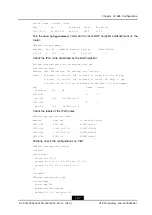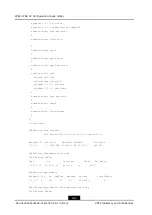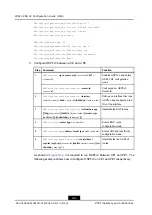
ZXR10 ZSR V2 Configuration Guide (IPv6)
neighbor 2.2.2.2 remote-as 100
neighbor 2.2.2.2 activate
neighbor 2.2.2.2 update-source loopback1
address-family ipv4 multicast
$
address-family l2vpn vpls
$
address-family vpnv4
$
address-family vpnv4 mcast
$
address-family vpnv4 multicast
$
address-family ipv6
network 2255::/64
redistribute connected
neighbor 2.2.2.2 activate
neighbor 2.2.2.2 send-label
$
address-family ipv6 multicast
$
address-family vpnv6
$
address-family route-target
$
$
!</route-bgp>
Run the
show ip ospf neighbor
command to check OSPF neighbor establishment on the
router. If the State is FULL, it indicates that the neighbor has been established, as shown
below:
PE1#show ip ospf neighbor
OSPF Router with ID (1.1.1.1) (Process ID 1)
Neighbor ID
Pri State
DeadTime
Address
Interface
2.2.2.2
1
FULL/DR
00:00:35
56.41.10.10
gei-3/9
Verify that the OSPF neighbor has advertised the loopback1 route, as shown below:
PE1#show ip forwarding route ospf
IPv4
Routing
Table:
Headers:
Dest:
Destination,
Gw:
Gateway,
Pri:
Priority;
Codes
:
BROADC:
Broadcast,
USER-I:
User-ipaddr,
USER-S:
User-special,
MULTIC:
Multicast,
USER-N:
User-network,
DHCP-D:
DHCP-DFT,
ASBR-V:
ASBR-VPN,
STAT-V:
Static-VRF,
DHCP-S:
DHCP-static,
GW-FWD:
PS-BUSI,
NAT64:
Stateless-NAT64,
LDP-A:
LDP-area,
GW-UE:
PS-USER,
P-VRF:
Per-VRF-label,
TE:
RSVP-TE;
18-6
SJ-20140504150128-018|2014-05-10 (R1.0)
ZTE Proprietary and Confidential
















































